Tudor and its Heritage – How the Vintage Submariners inspired the Tudor Black Bay
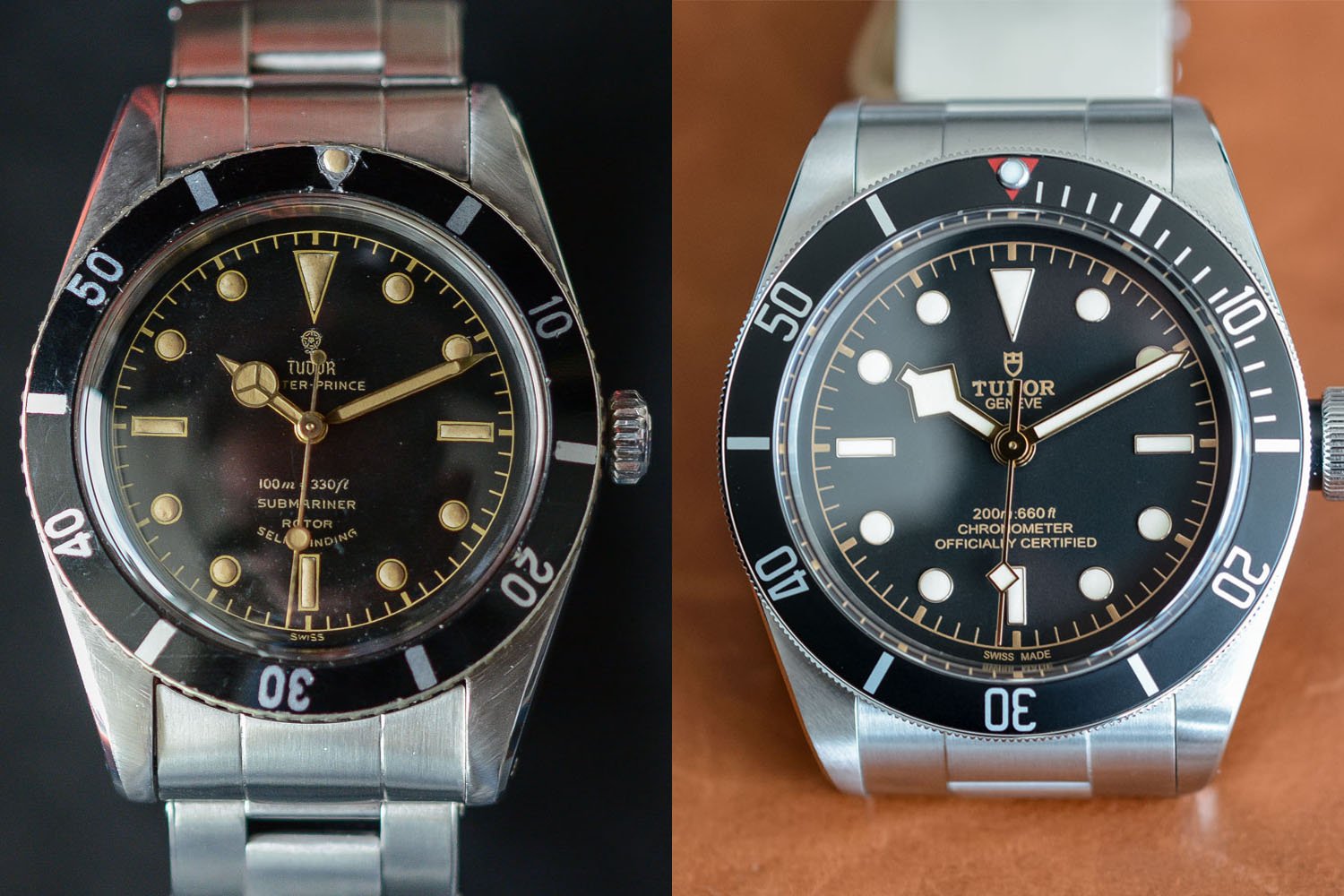
In terms of product design, vintage inspiration has been, for the last 10 years, one of the major, if not the major trend. Most brands, from low-end to ultra-luxury have been, at least once, looking at their past and used it as a reference to create new models. We all need strong foundations to feel confident, and this must be a part of the explanation. However, as always, some handled this vintage style with success, some didn’t. In the middle of this crowd, one brand must be regarded with great care: Tudor. With their Heritage line, they clearly played on this trend and achieved probably better than most around. To every success there’s an explanation, and here, it must the combination of vintage elements into a modern package, and not just a copy-paste of the past. Today, we start a series about Tudor and its Heritage and we’ll look at how the Vintage Submariners inspired the Tudor Black Bay (and inspired only…)
When Tudor has been relaunched at the end of the 2000s, they never hide the fact that vintage and heritage was a great part of their inspiration. No one can ignore that the brand’s best seller, the Tudor Heritage Black Bay, was greatly inspired by the Submariner watches (yes, plural, it’s extremely important) from the 1950s, 1960s and 1970s. When it has been first unveiled at Baselworld 2012, all of us immediately saw the link with the past of the brand and some of its iconic models. However, we also noticed that the Black Bay was using elements of several references, not just one of them, and was integrating them into an overall modern, sporty and highly qualitative package. This is where the brand caught us all (in a good way). Before we look at the Tudor Heritage Black bay in details, spot the elements of the past that have been included and do an early (really early) retrospective of this model, we have to study the watches that have been used as inspirations to create this successful model.
The Submariner family in Tudor’s history
From left to right – Tudor Submariner 7922 (1954) – Tudor Submariner 7923 (1955) – Tudor Submariner 7924 (1958)
Tudor Watches was born in 1926, in Hans Wilsdorf’s mind, as such: “I have been considering the idea of making a watch that our agents could sell at a more modest price than our Rolex watches, and yet one that would attain the standard of dependability for which Rolex is famous.” The roots of the brand were here: quality, functionality, reliability, and for a more accessible price than the mother brand Rolex. The bases of the “accessible luxury” concept, which is now used all over the place, were there. While not being proper dress watches, the first models of Tudor were not real tools or watches with a strong sports vocations either, like it is the case now for most of the collection. This concept really started in 1954, when Tudor launched their version of the Submariner, the iconic dive watch created in 1953 by Rolex.
The 1954 Tudor Oyster Prince Submariner 7922
From 1954 to 1999, there would always be a Tudor Oyster Prince Submariner in the collection, demonstrating the brand’s vision of the accessible and performing dive watch. After a break of 13 years, in 2012, a same concept came back to life with the Heritage Black Bay collection, the worthy successor of the legendary Submariners.
Designed from its origin to fulfill criteria of durability, reliability, precision and waterproofness at a moderate price (thanks to outsourced movements mostly from ETA and not in-house movements like Rolex), the Tudor Submariner quickly positioned itself as a strong professional instrument. The first generation of Submariners, all from the 79xx series, were certainly the greatest inspiration for the development of the current Black Bay and this is why we will mainly focus on these references. This first generation saw several versions and evolutions, showing the research and development done by Tudor to achieve their own conception of an ideal dive watch. What was certainly not clear in 1954, in the early days of the watches for divers, with evolutions that would be later retained or not, created the legend and many sources of inspiration for the development of the different versions of the Heritage Black Bay.
The first of its kind, the Tudor Oyster Prince Submariner 7922
When looking at this first generation of Submariner by Tudor, we can’t hide the fact that it is greatly inspired and has a huge resemblance with the ref. 6402 from Rolex, a.k.a the first Submariner launched in 1953. The Tudor Oyster Prince Submariner 7922 is indeed based on a Rolex case with Rolex bracelet and Rolex crown (that was the norm at that time for Tudor) and shares many of its specifications with its sister from the “Crown”. However, we can’t hide either the importance of this watch for Tudor, as being the first of its kind: it is simply the first proper diving instrument made by the brand, following the first attempts done with waterproof watches. But here, this watch aim to please professional divers. It indeed has all the attributes a 1950s dive watch should have.
The case of the Tudor Oyster Prince Submariner 7922 was already water resistant to 100m / 330ft (as written on the dial), had a rotating bezel (bidirectional at that time… unidirectional bezels will come later, as a safety feature) and a screwed caseback and crown. The bezel was already graduated in 5-minute intervals to precisely measure dive time and allow for the adjustment of the decompression stages. The black lacquered dial was domed (keep this in mind), it had gilt indexes and hands (to keep in mind too) and, regarding the inscriptions, we can find a specificity: the “smily” curved “SELF-WINDING” at 6, with “ROTOR” mention (again, something to remember for later). At that time, the hands retained the Rolex look, with Mercedes hour hand – the signature snowflake hands will come later. indexes were showing painted dots, to the exception of the bars at 3, 6 and 9 and a long triangle at 12.
The case was stainless steel, with straight casebands, no protection for the crown (a small 5mm one), some bevels on the sides of the brushed lugs – again, these are features to remember. On top of the dial was a domed glass, in acrylic. Inside the case was an outsourced self-winding movement, calibre 390, based on a Fleurier movement-blank with a frequency of 18,000 beats per hour. The logo used on the dial was the Rose.
The hyper-rare one, the Tudor Oyster Submariner 7923
With the Tudor Oyster Submariner 7923, we are talking about an exceptional, rare and completely unique watch in the history of the Submariner, whether from Tudor or the entire Rolex Group. What you have in front you, even if extremely similar to the previous ref. 7922 (which was not replaced by this 7923), is the only known manual winding version of the Submariner. And it makes this watch one of the thinnest Submariner (if the not the thinnest) ever made. The overall appearance of the Tudor Oyster Submariner 7923 (non “Prince”, as not automatic) is close to the 7922, with the same kind of bezel, the same overall dial design (gilt indexes and tracks are identical), the same bracelet (with a major difference though) and the same small crown.
There are evolutions however in this Ref. 7923, and not only for the movement. Of course because of the manual movement, the case is slimmer, but it retains the screwed caseback engraved Rolex. The main differences come from details of the dial. Indeed, the hands are now more standard batons with triangular tips (a detail that you’d better remember) and the second hand has a different style, with the round luminous part on the tip. Also, because of the manual calibre, the inscriptions on the dial are different, with now 2 lines of text at 6 – “submariner” and “shock-resistant”.
Inside the case was a manually-wound ETA calibre 1182 with a frequency of 18,000 beats per hour – a movement close from an ETA Peseux. One last detail that makes this watch somehow unique and different from all the other Submariners is the way the bracelet is attached to the case. Indeed, the Oyster-type bracelet with riveted links reference 6636 was not secured to the case by common curved end links but by two straight cylindrical bars.
The Tudor Oyster Prince Submariner 7924
This watch, the Tudor Oyster Prince Submariner 7924, can be seen as the technical evolution of the two first versions, with improvements mainly in the functionalities and in the water resistance, even though slight visual differences can be seen. In terms of case (still 37mm), bracelet, dial and hands, finishings and main details, the watch is entirely similar to the 7922. Even the movement used is the same. However, this watch that appeared on the market in 1958 followed the evolutions done by Rolex on their Submariner, with the reference 6538, launched in 1957, with a 200m / 660ft depth rating (instead of 100m before). To reach this new threshold, the case of the Submariner 7924 had been made thicker and was equipped with a larger screw-down crown, which gave this watch the nickname “Big Crown“. Instead of 5mm in diameter, the crown (still with Rolex logo) was now 8mm in diameter, however still not protected, as the case was still straight.
In addition to this thicker case and this new crown, the Tudor Oyster Prince Submariner 7924 also featured a stronger Tropic-type Plexiglas crystal, thicker and dome-shaped, for a better resistance to the pressure, when diving close to 200m under the sea level. In terms of details, we can notice a diving bezel with 15-minute scale from 0 to 15 and markers every minute. Finally, some examples (like the first one showed here) have a red triangle at 12 on the bezel, again a detail that has its importance. This watch, reference 7924, was the last of the straight Submariners.
The transitional one, The Tudor Oyster Prince Submariner “Square Crown Guards” 7928
While the following reference was still part of the 79xx series, it also marked the transition to a new generation of watches, showing the evolution wanted by Tudor and a stronger differentiation between the watches made by the Rose and the watches made by the Crown. Indeed, the 1959 Tudor Oyster Prince Submariner 7928 can be seen as a transitional version, mixing elements of the old generation and details of the coming versions. This watch is remarkable because of the introduction for the first time of guards to protect the winding crown from shocks. This new features show the constant technical evolution made in the early days of the Tudor Submariner. However, the present example, from the early times of this reference, show a specific square version of these protections, called “Square Crown Guards”.
Still, if the case has a rather different shape, the 7928 keeps the same type of dial as the previous watches from the 79xx series: gilt hands and inscriptions, same indexes, curved inscription at 6, Mercedes minute hand… The watch was still water-resistant to 200m but grew in diameter, to achieve 39mm. The crown, because of the protection, needed to be smaller, at 6mm only.
The Tudor Oyster Prince Submariner “Tropical” 7928
While this watch doesn’t show a real technical or historical importance, it has the be noticed for its look. Indeed, the present example of Tudor Oyster Prince Submariner 7928, to the exception of the rounded guards to protect the winding crown, is similar to the previous version. However, due to its age, the watch underwent a discoloration process, which ended in a slightly “tropical” dial and a faded bezel, which turned blue. Thus, we have a combination here of a black dial with silver indexes, with a faded blue bezel. Something that might have given Tudor’s designers some idea for the current Black Bay blue… just saying.
The Tudor Oyster Prince Submariner 9401 “SnowFlake”
Once again, with this Tudor Oyster Prince Submariner 9401, we have a watch that shows interest not on a mechanical or technical side (even if features an evolution of movement) but that clearly have a strong interest in terms of design. It indeed features the combination of a blue dial with blue bezel, with the signature hands and indexes of the brand, introduced first on the Submariner 7016 in 1969: the squared hour indexes (that can be found on the Pelagos) and mainly the SnowFlake hour hand, which will later become an iconic feature of Tudor’s dive watches.
The influence of these vintage Tudor Submariners on the modern Tudor Heritage Black Bay
Now that we have been looking at all these great vintage watches by Tudor, you certainly know where we’re bringing you. If you can figure out what a Tudor Black Bay looks like, you have certainly spotted some of the elements that are now integrated in this great modern watch, as source of inspiration for its design.
The Tudor Black Bay was introduced in 2012, at Baselworld. it was first showed in a burgundy edition (somehow already seen at Tudor in the 1990s) to later be followed by a midnight blue edition and a black one. The case of 42mm clearly projects this watch in modernity however it boasts, as we’re going to see in a bit, numerous vintage elements that refers to the past. Two executions of the watch exist: a 1st generation from March 2012 to March 2016, with an out-sourced movement (ETA 2824, slightly modified by Tudor), with standard Oyster-style bracelet and the curved logo at 6 – a 2nd generations, launched at Baselworld 2016, with in-house movement (calibre MT5602), a rivet bracelet and different inscriptions on the dial. These exceptions apart, the watch remains overall the same, and so are the 3 editions: burgundy, blue, black.
Tudor Heritage Black Bay 79220B first generation, with curved inscription at 6
What are the elements of the past in the Black Bay and where do they come from?
- The straight case – something that can be seen on the early 79xx series, with tapered lugs and bevels on the sides – all of that can be found in the 7922, the 7923 and the 7924
- The “Big Crown” refers to the reference 7924
- The domed and slightly grained dial – this domed profile of the dial can be seen on all the early Tudor Submariners. The grained aspect however pays tribute to the aging process of these dial. This combination gives the dial a great vintage aspect, in addition to be legible (matte, without reflections)
- The indexes, with dots, bars and triangle at 6 – again, something that can be found on all the early Submariners
- The bezel, with markers every minute from 0 to 15 and then markers every 5 minutes – the same style as introduced on the 7924.
- The logo. The Black Bay 1st generation uses the old logo of Tudor – this has changed on the 2nd generation, which uses the modern Shield logo.
- The “smily face”, with inscription “ROTOR” and “SELF-WIDING” at 6. Again, this refers to the ref. 7922 and 7924
- The SnowFlake hands, with the same hour hand and second hand than the 1960s and 1970s Submariners – square luminous marker for the hours and the seconds. Simple baton for the minutes.
- The gilt hands and indexes of the black and burgundy editions. This refers to the vintage Submariners of the 1950s and early 1960s.
- The red triangle on the bezel of the Tudor Back Bay black, something that could be found on certain 7924 watches.
- The combination of black dial, silver inscriptions and tracks, with a dark blue bezel. This seems to be inspired by the “tropical” Submariner 7928 showed before.
- The reference number of the first generation: 79220, as a tribute to the first Tudor Submariner 7922
2nd generation of the Tudor Heritage Black Bay, with manufacture movement
Some changes can be seen on the 2nd generation of the Tudor Black Bay, this time with manufacture movement. However, if some novelties can be seen on these watches, they are also coming from the past, like for instance the rivet bracelet, which was used during the 1950s and early 1960s. The new straight inscriptions at 6 are probably not as iconic as the curved ones of the first generation, however, they are relevant with certain later vintage editions.
All together, the Black Bay is a great mix of vintage elements in a modern package. The most surprising is that it doesn’t refer to one special watch but in fact uses parts of several watches, and the most iconic features of each of them (the curved letters, the red triangle, the gilt dial, the big crown, the SnowFlake hands…). While some brands play on the easy side of the vintage inspiration, Tudor chose to mix these elements to obtain a watch that doesn’t sound like a proper copy and that, in the end feels utterly balanced (something that was risky, as mixing too many iconic elements can become sort of a gimmick, but not here). This must be the reason of the success of this watch amongst all categories of watch lovers, whether hardcore ones or new comers. This watch has cool features, a strong movement (since 2016), a great price / quality ratio and superb construction. A success-story that should inspired some other brands, sometimes a bit too lazy in vintage reissues.
Before concluding this article, there’s a final and very special watch to look at: the unique Tudor Black Bay One auctioned for Only Watch 2015. Based on a normal Black Bay 1st generation, this edition pushed a bit further the vintage-inspiration, with a clear tribute to one specific model, the ref. 7923 – however without the manual movement.
Indeed, the Black Bay One Ref. 7923/001 (see the reference even in the serial number…) showed a glossy black dial (like vintage watches), some baton hands for both the hours and the minutes, a second hand with a round luminous tip at the right end of the hand and a dial with 2 straight line of text, including “SHOCK-RESISTING”. All of that were clear references to the Ref. 7923, and even the bracelet, with two straight cylindrical bars instead of curved end-links was a tribute to this great and rare watch.
More details about Tudor, its history and the Heritage Black Bay on tudorwatch.com.

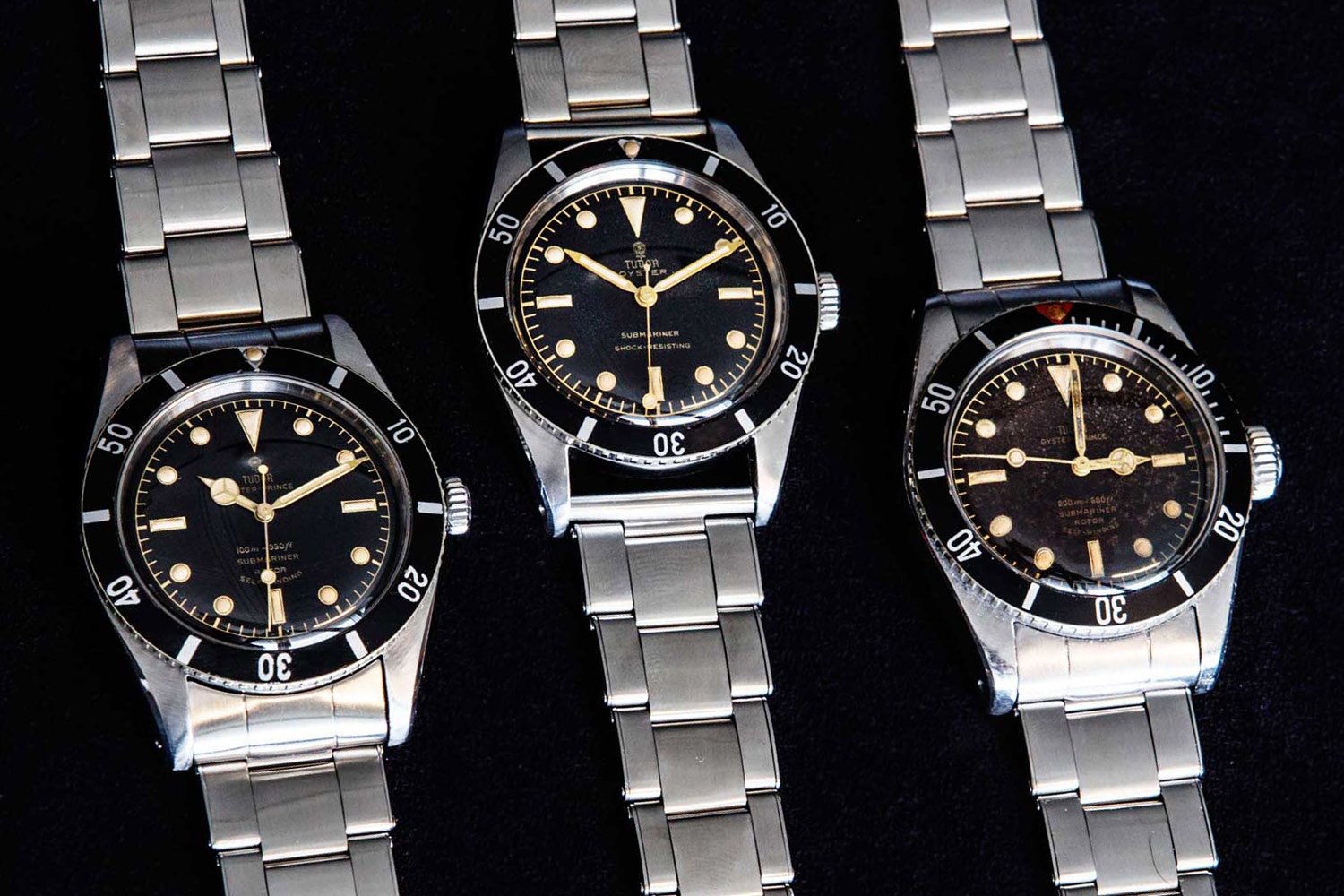
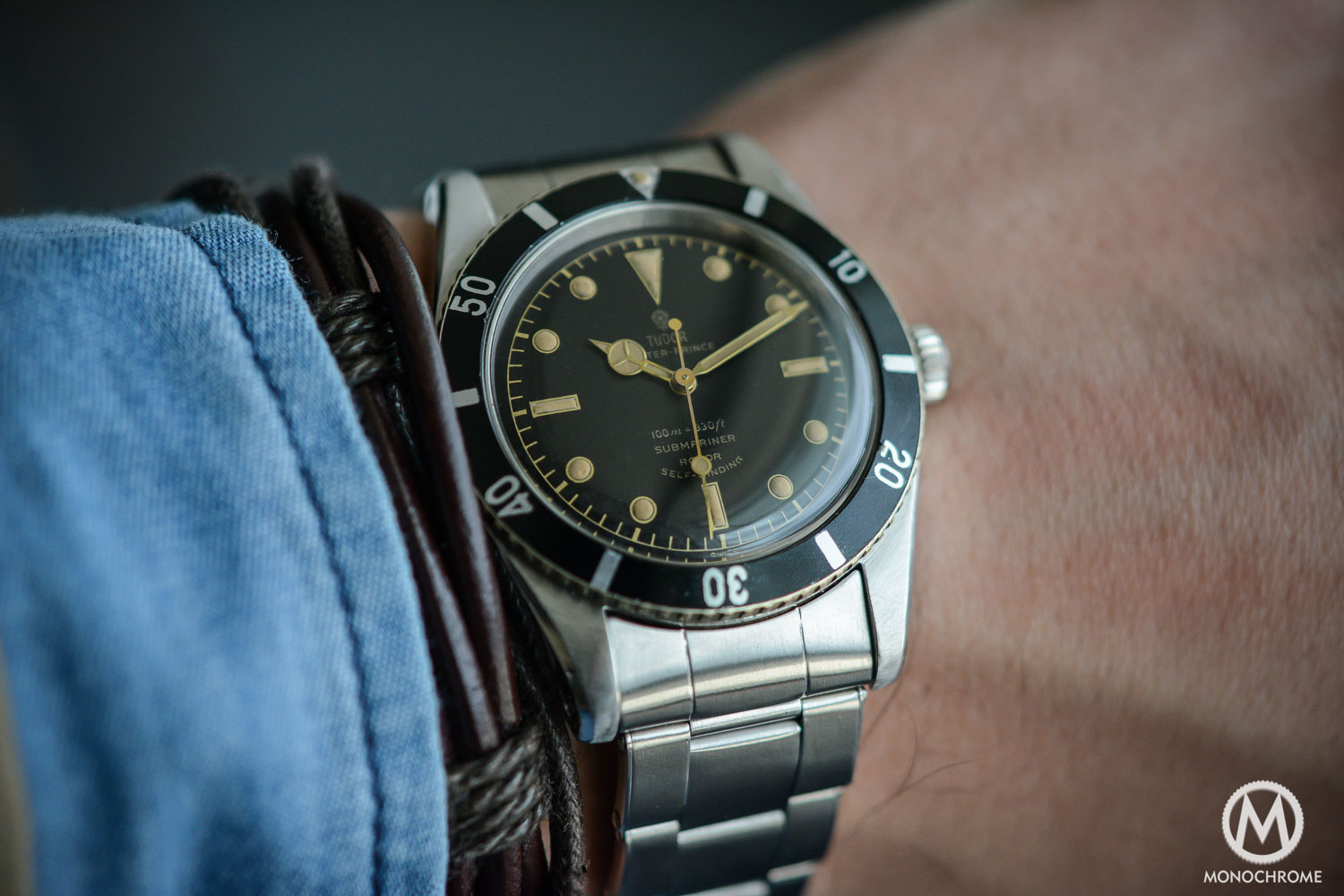
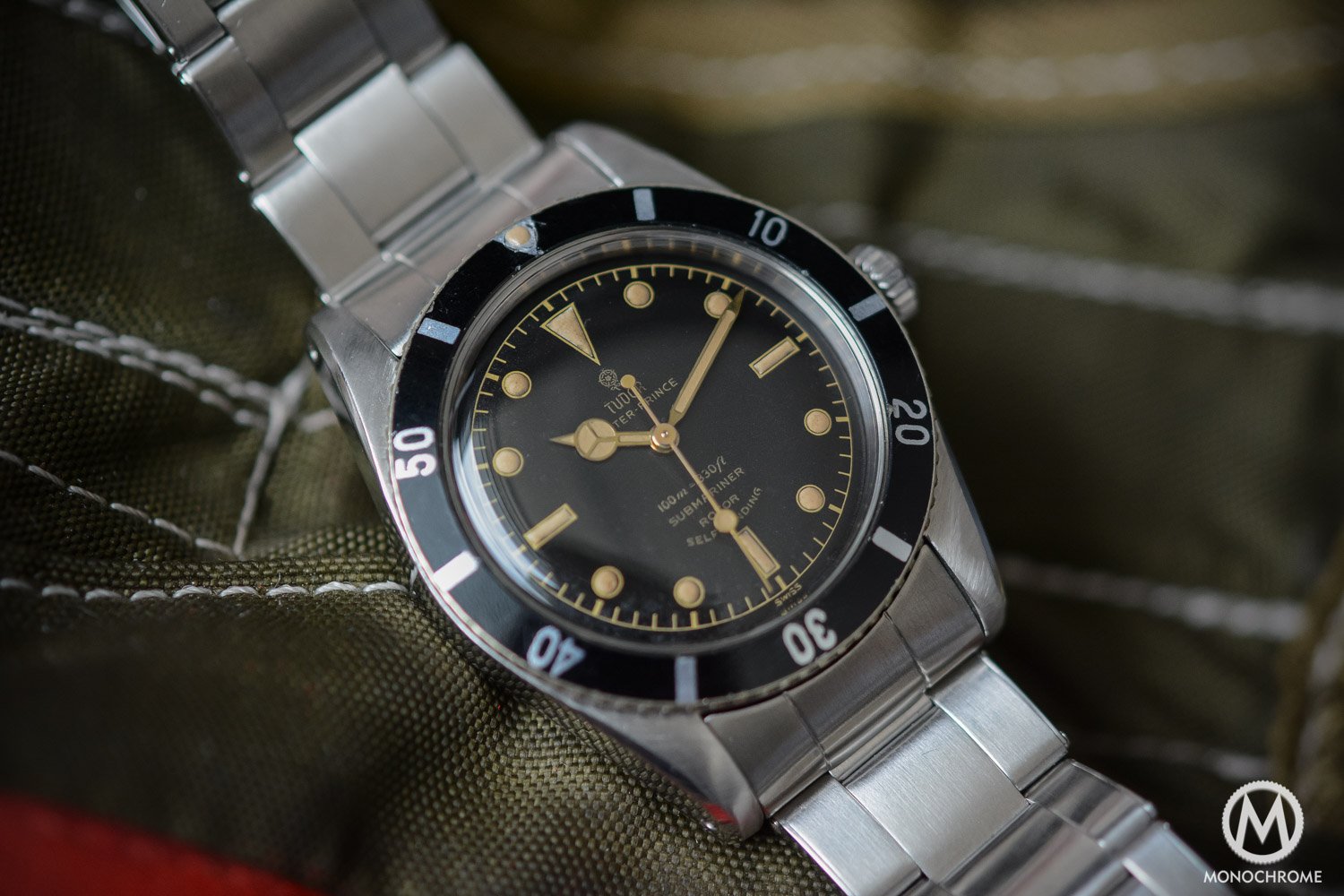
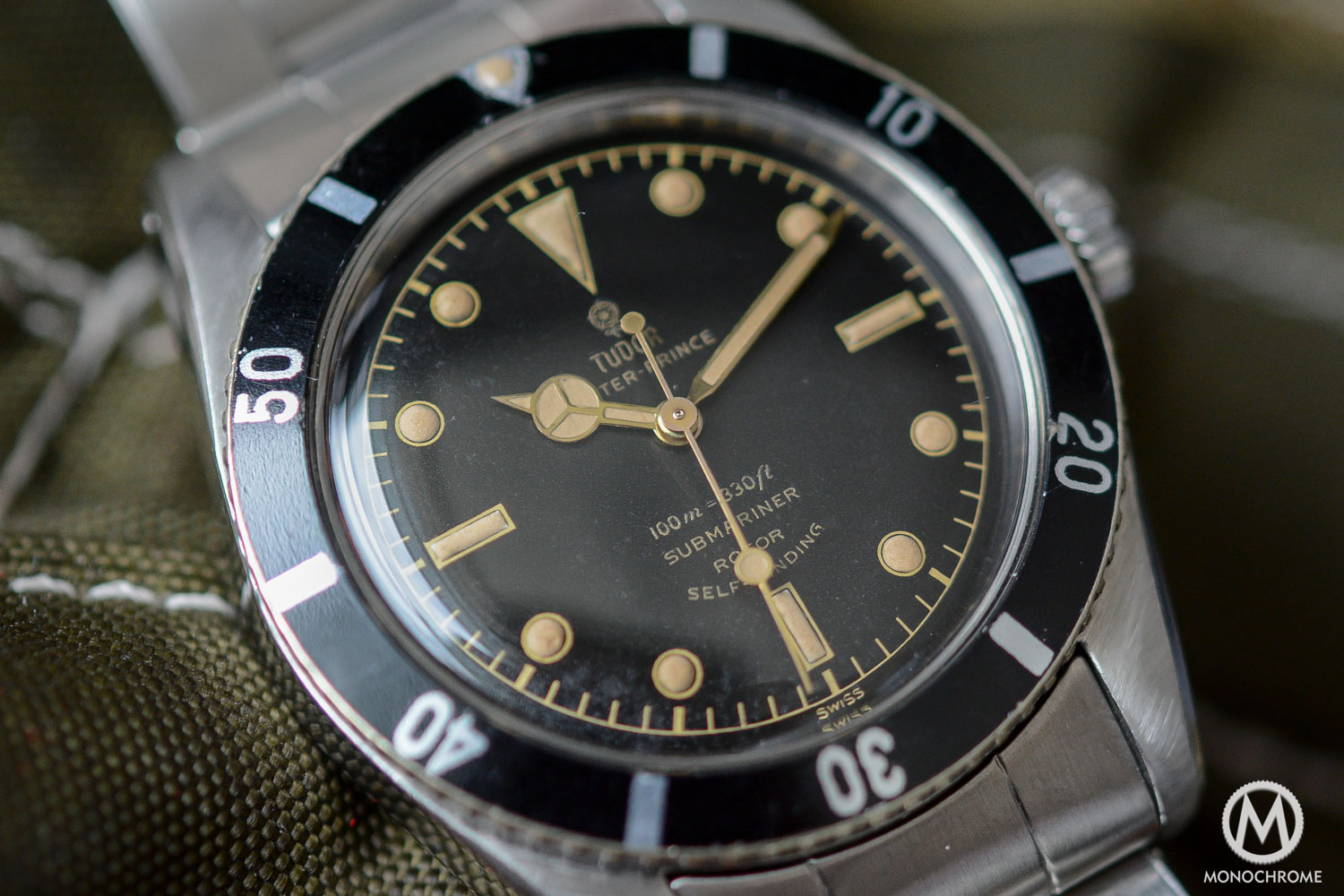
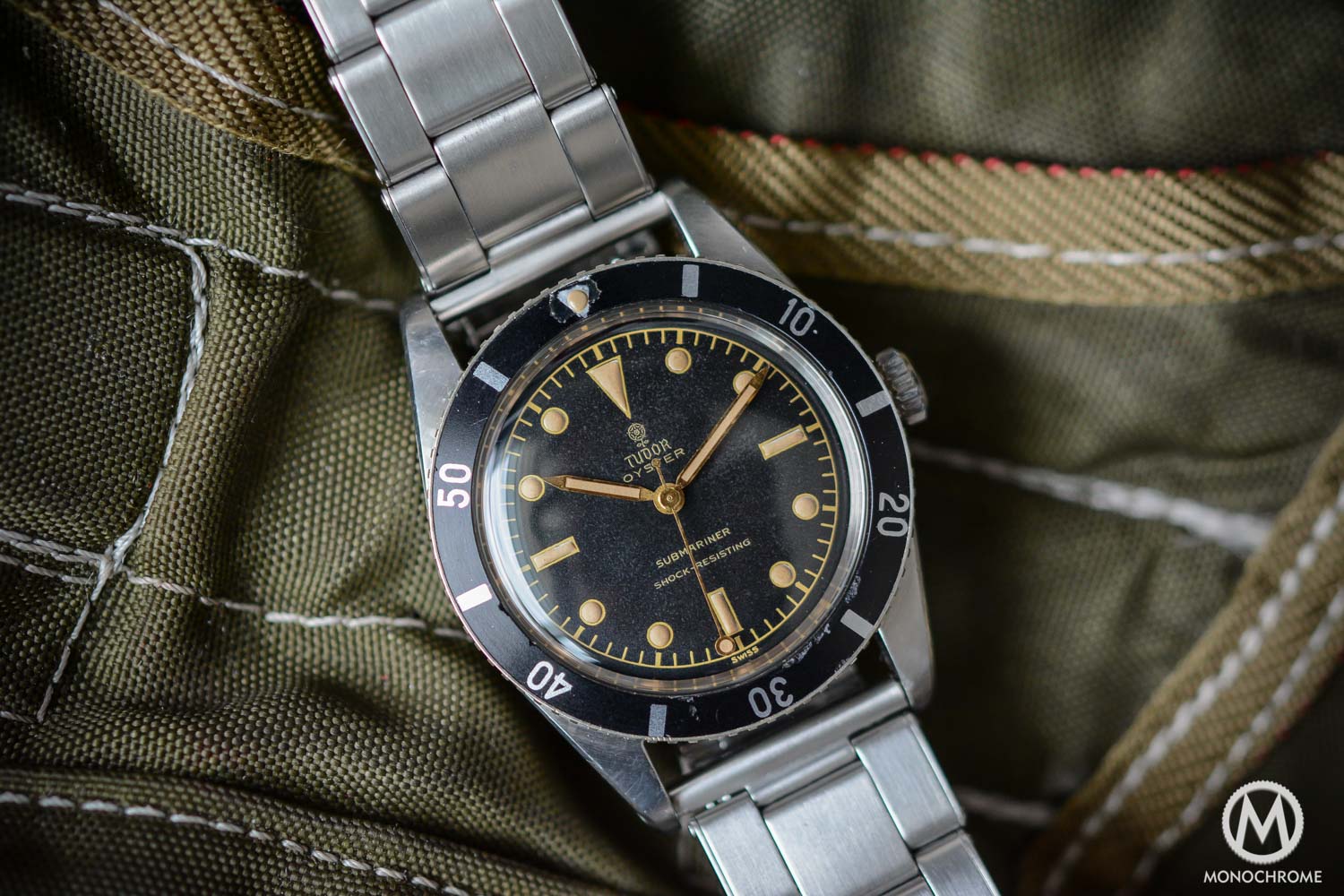
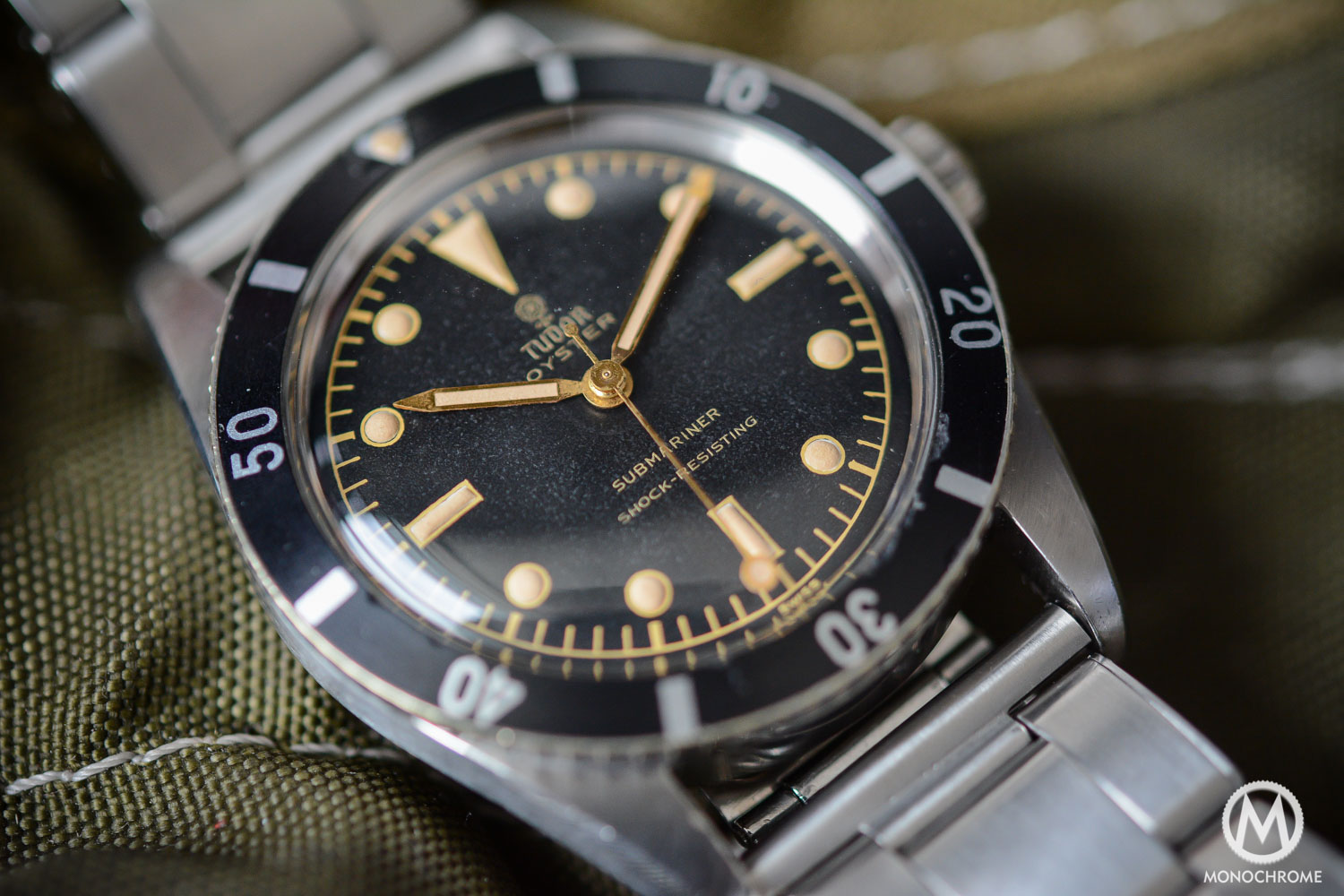
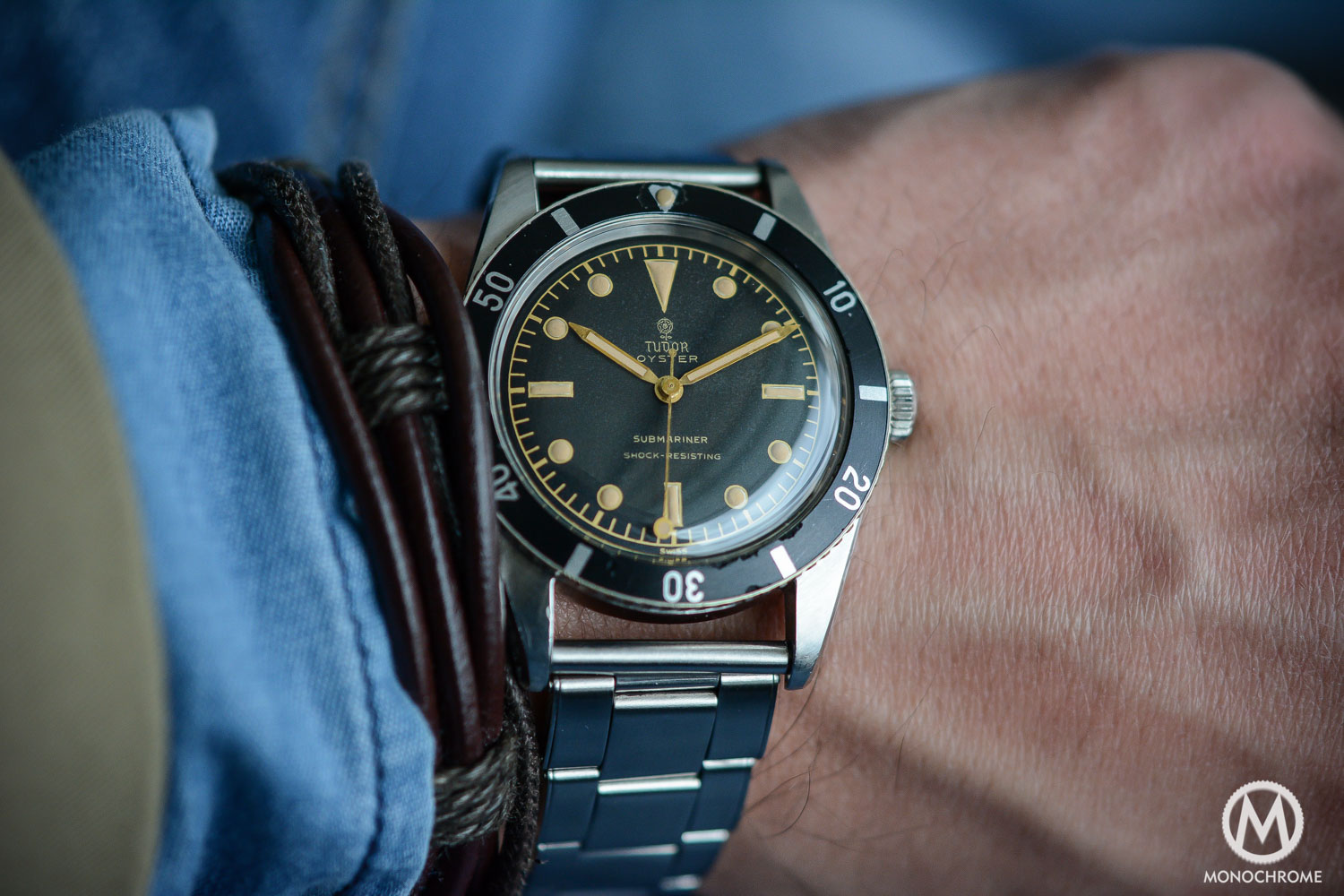
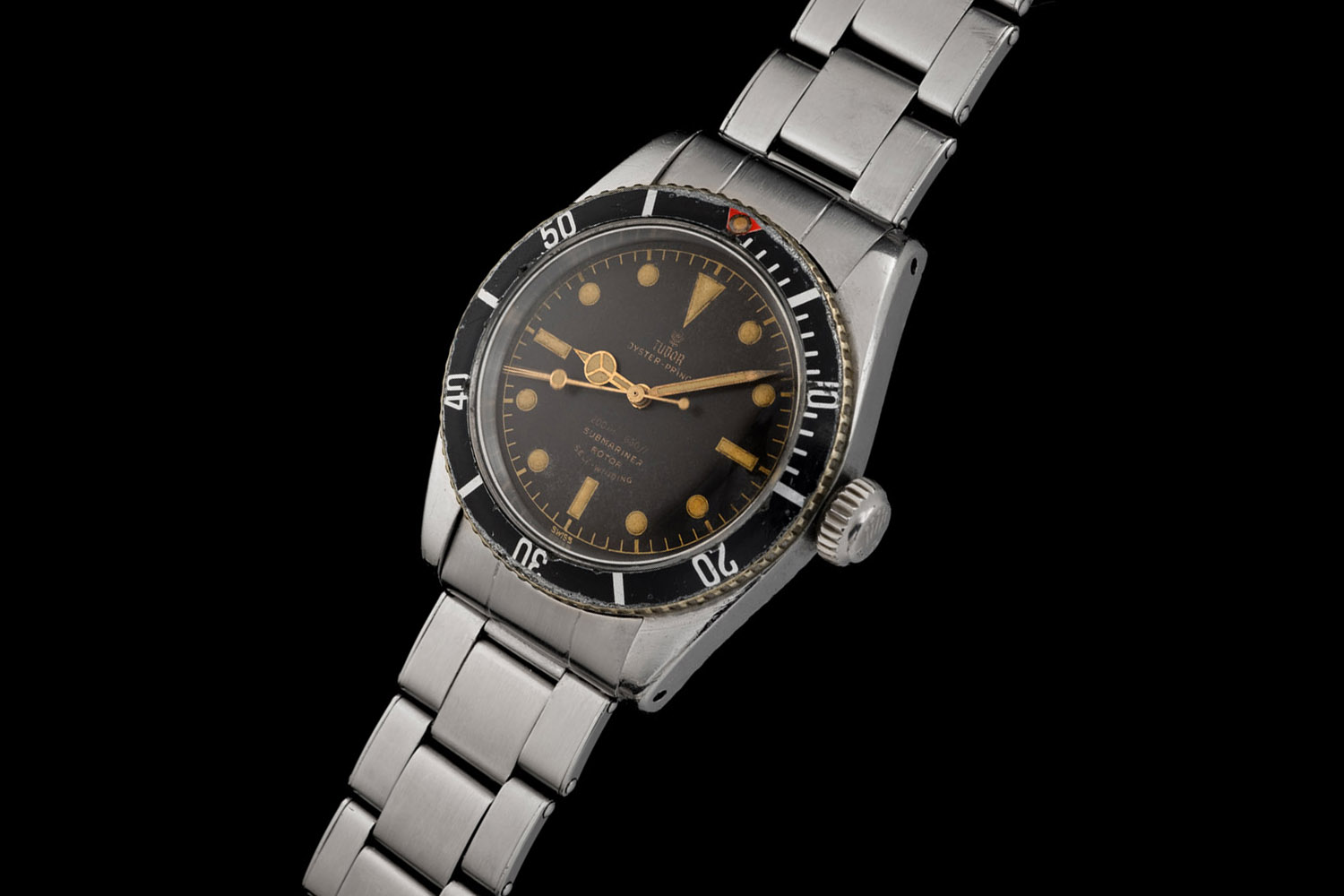

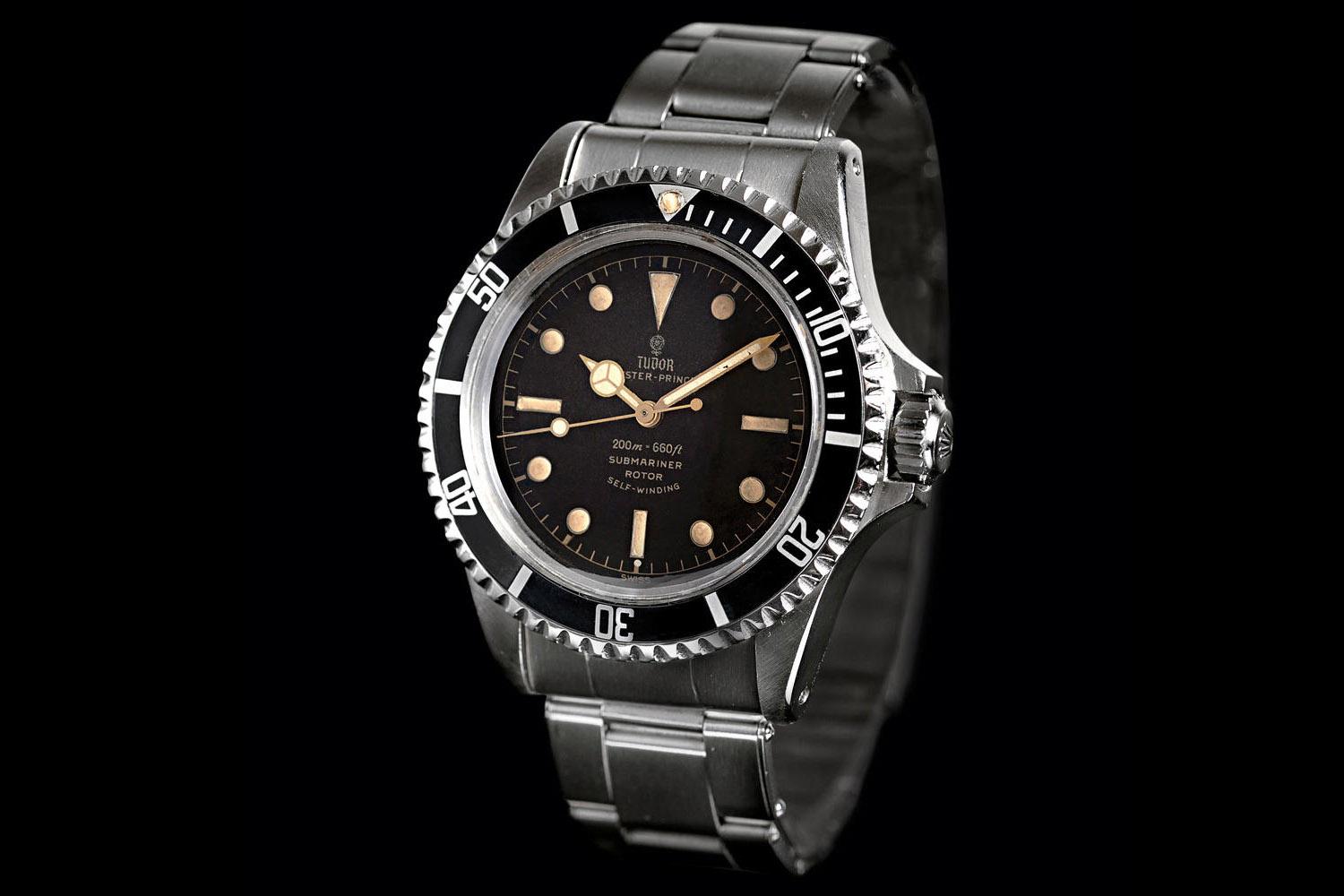
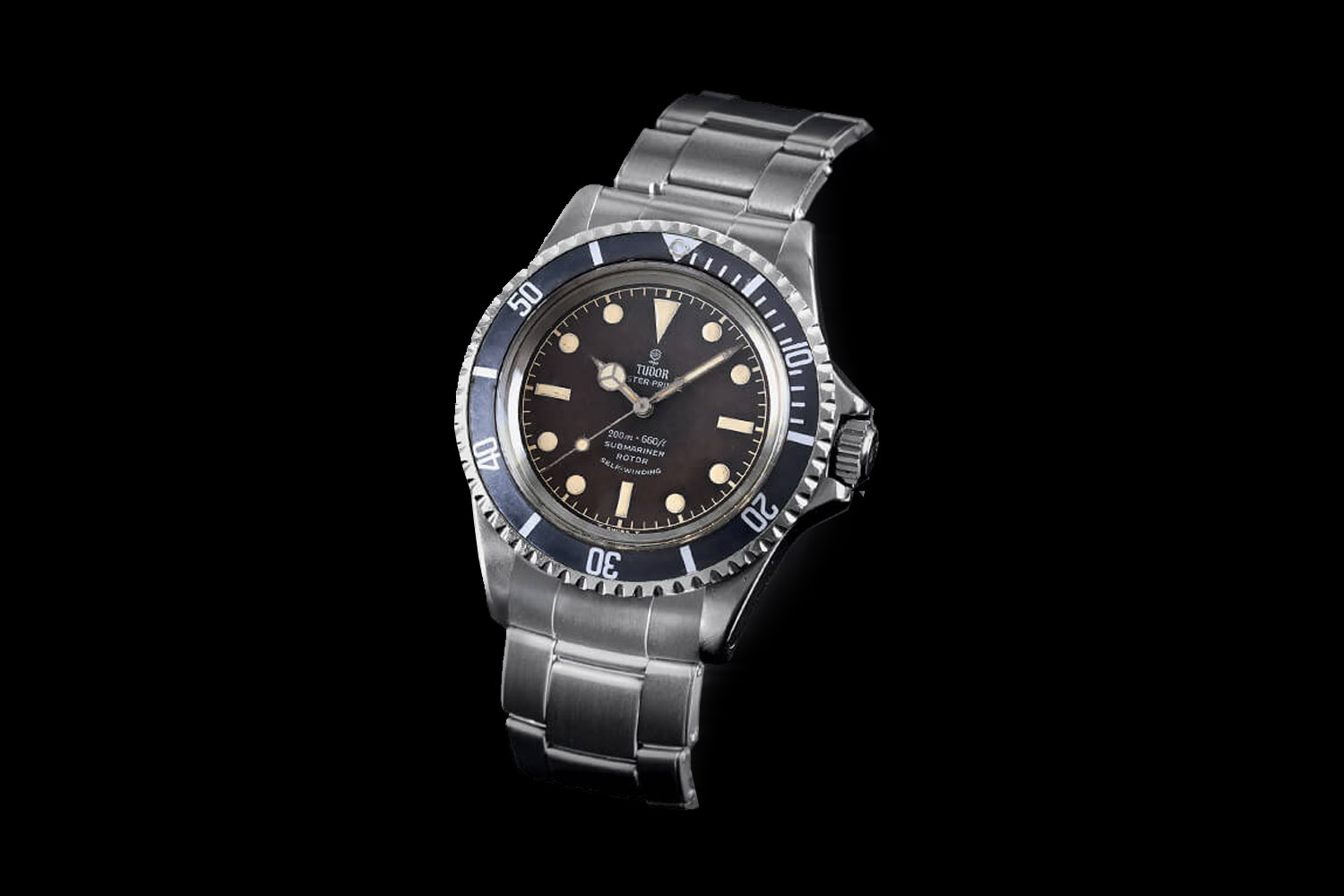
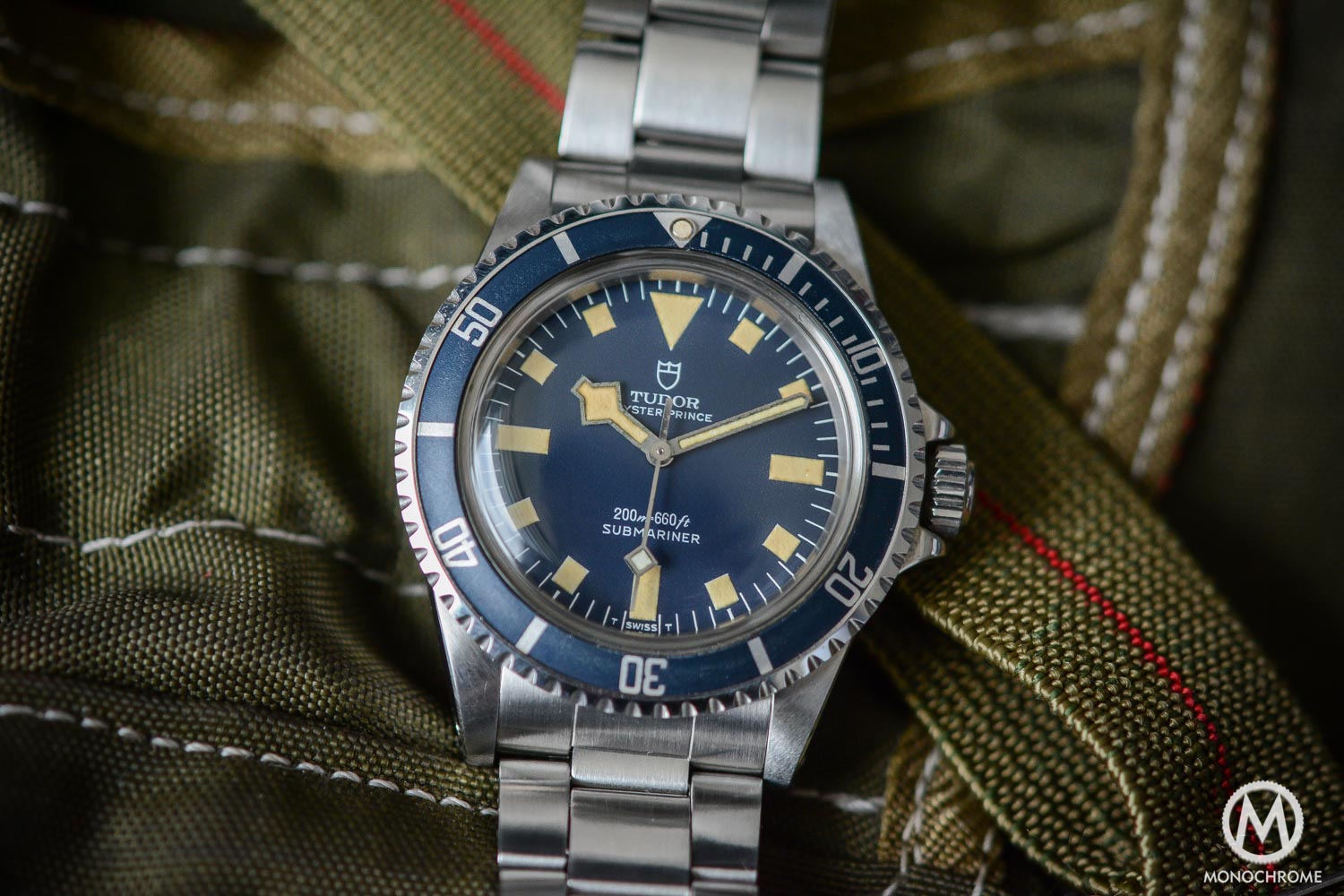
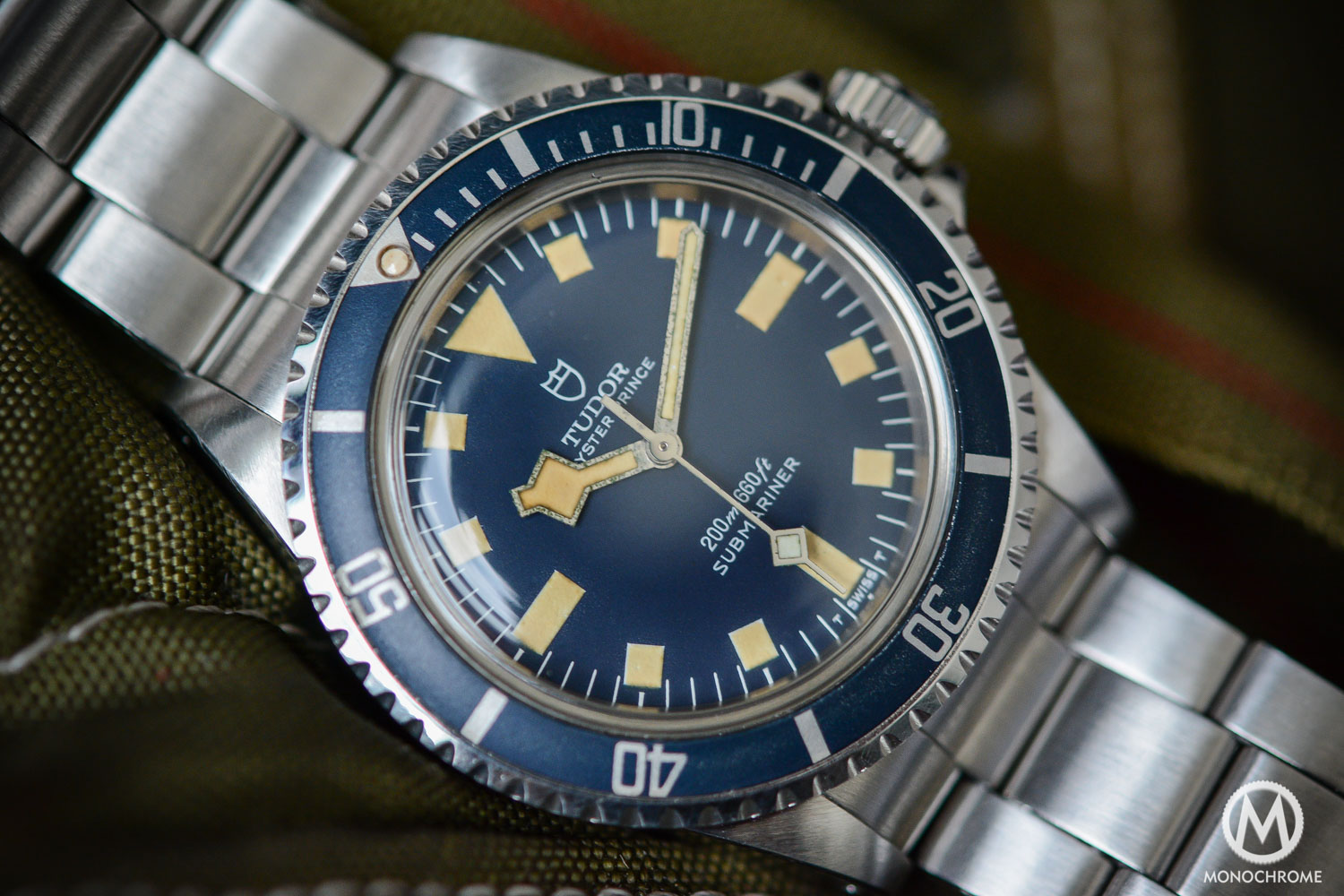
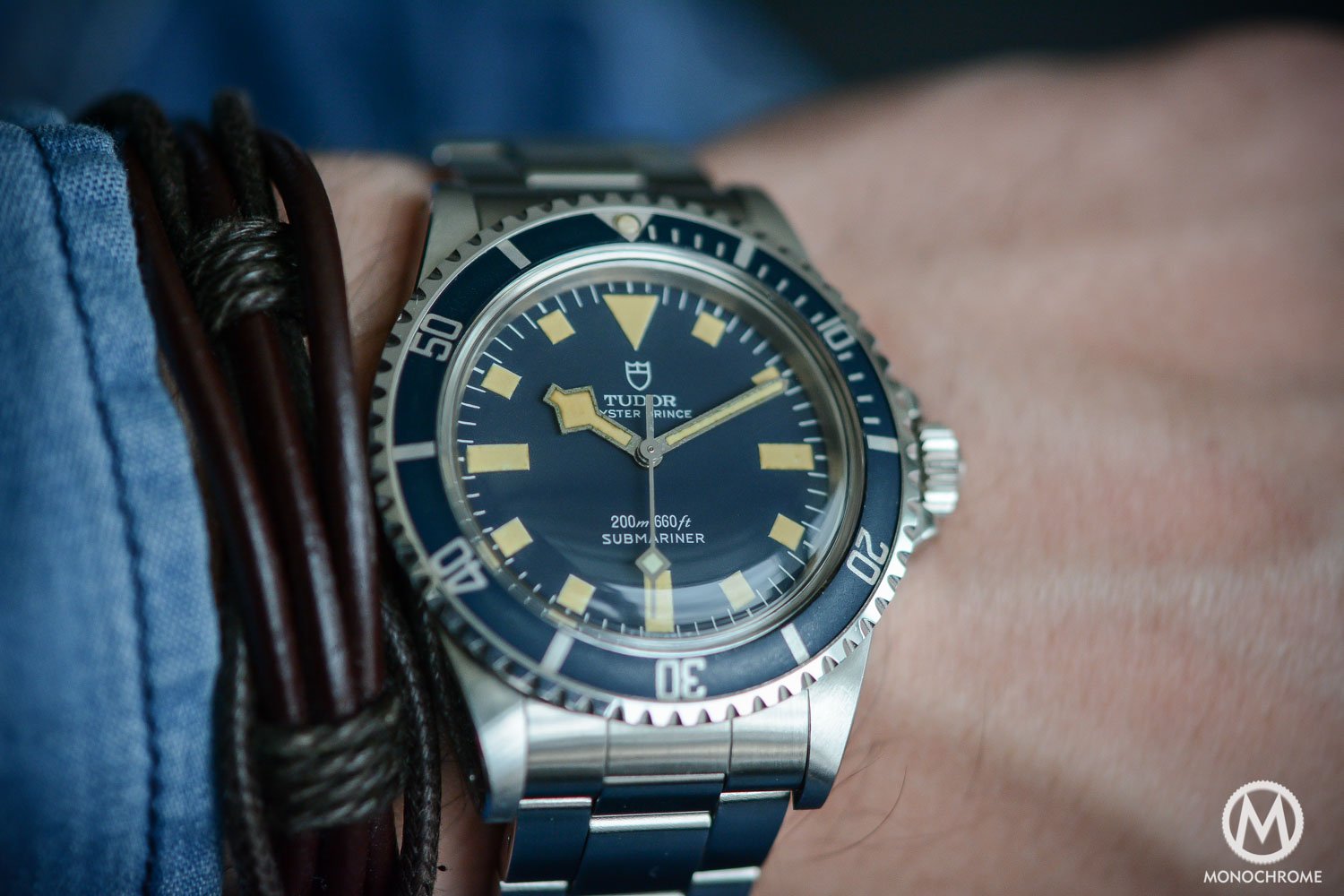
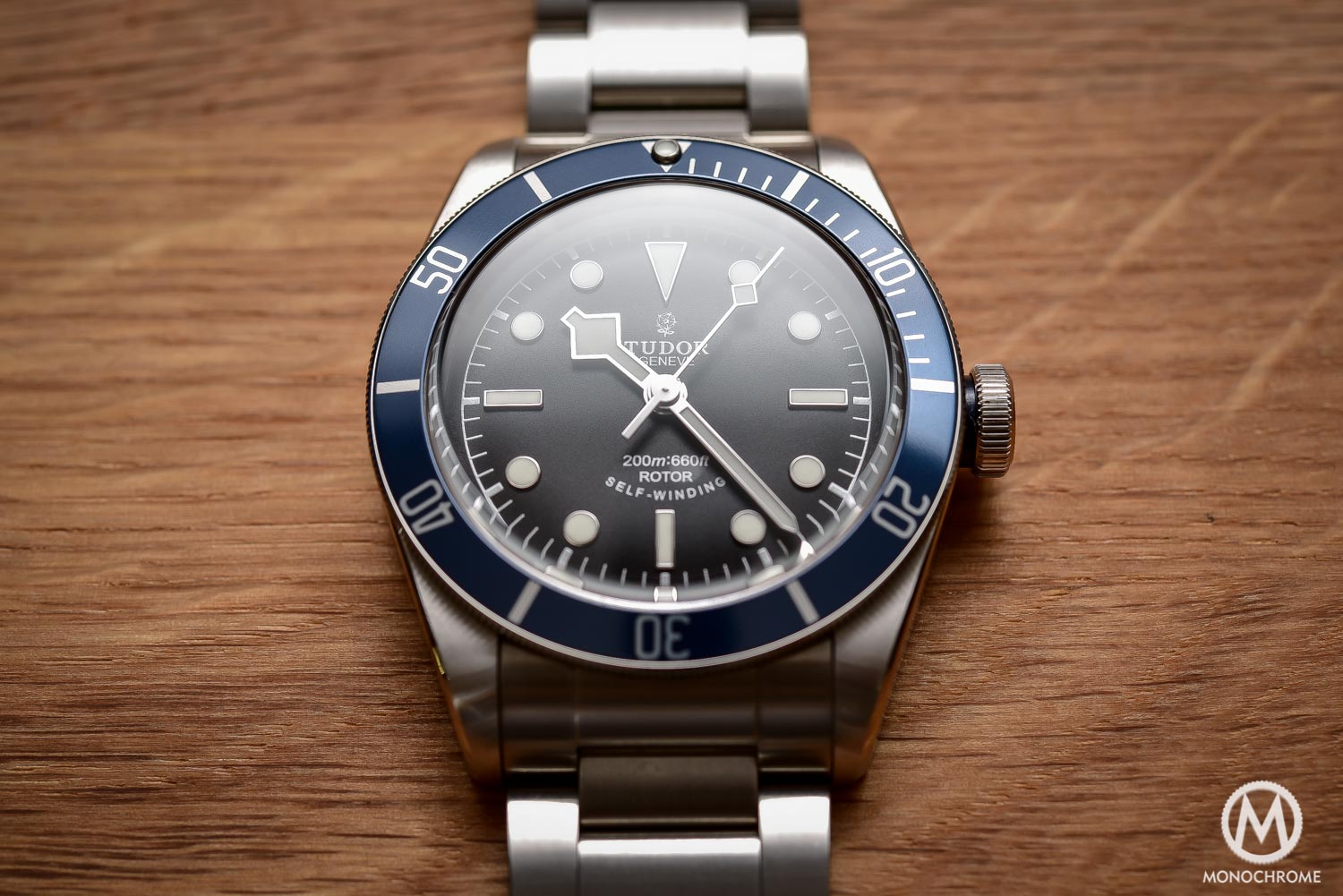
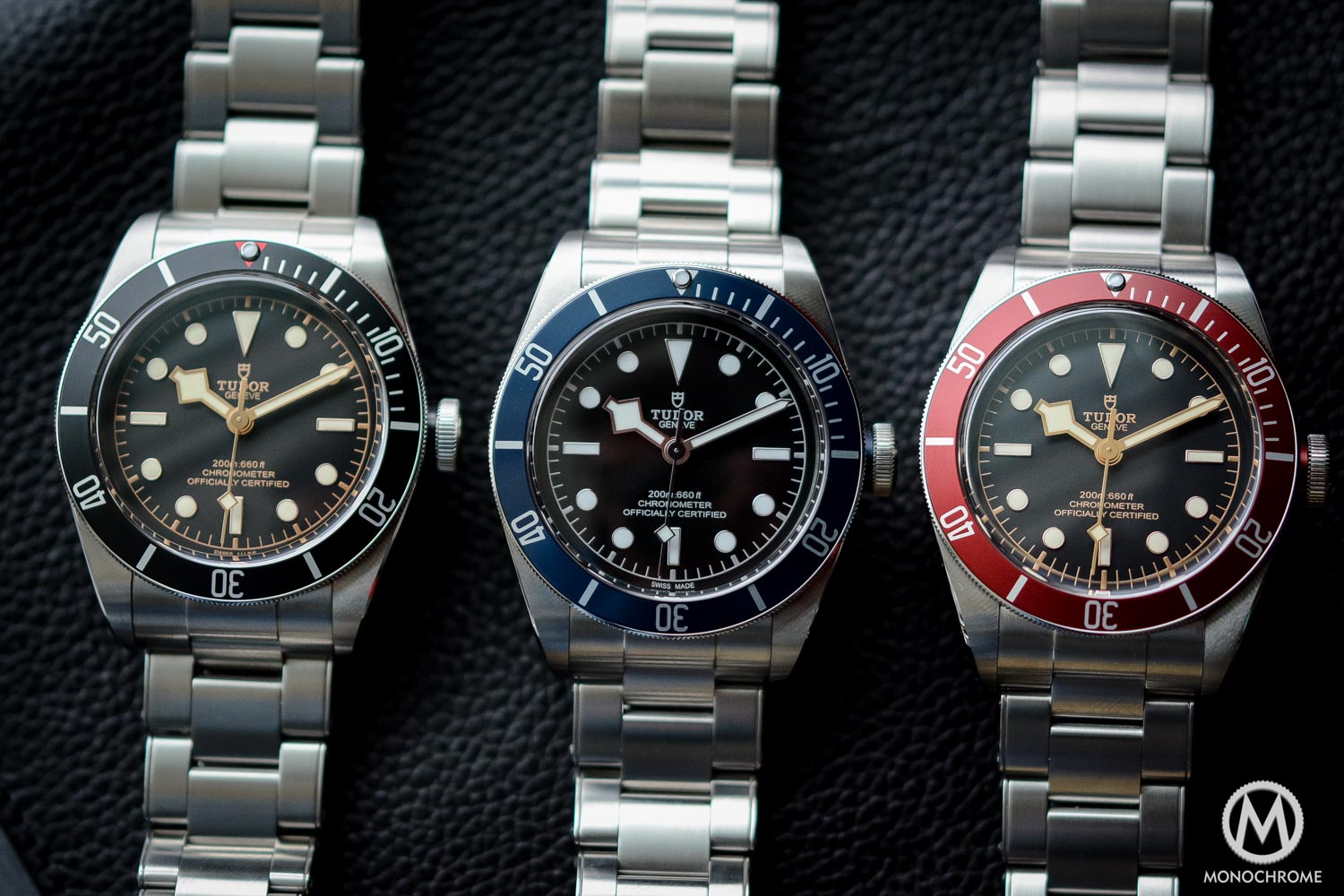
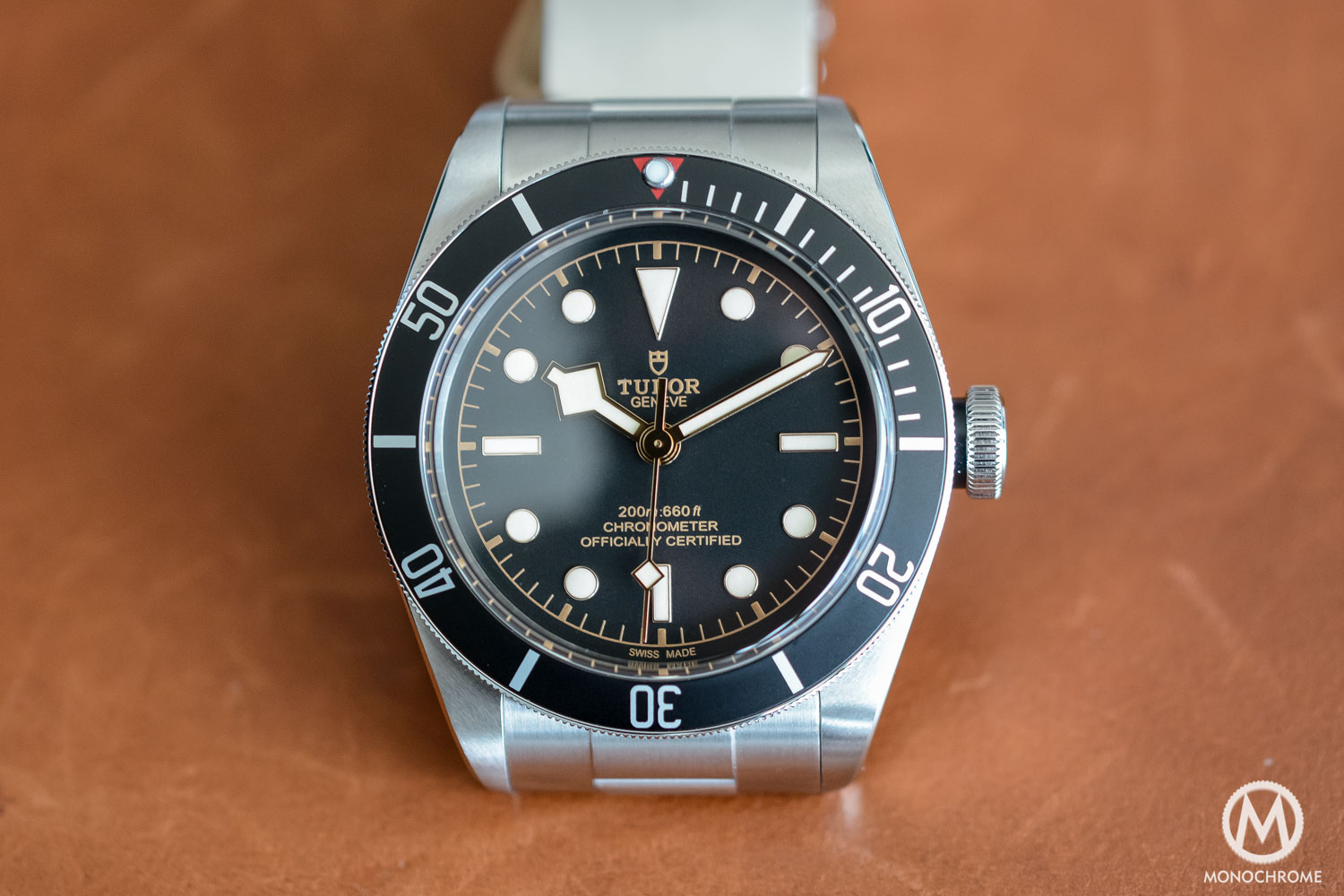
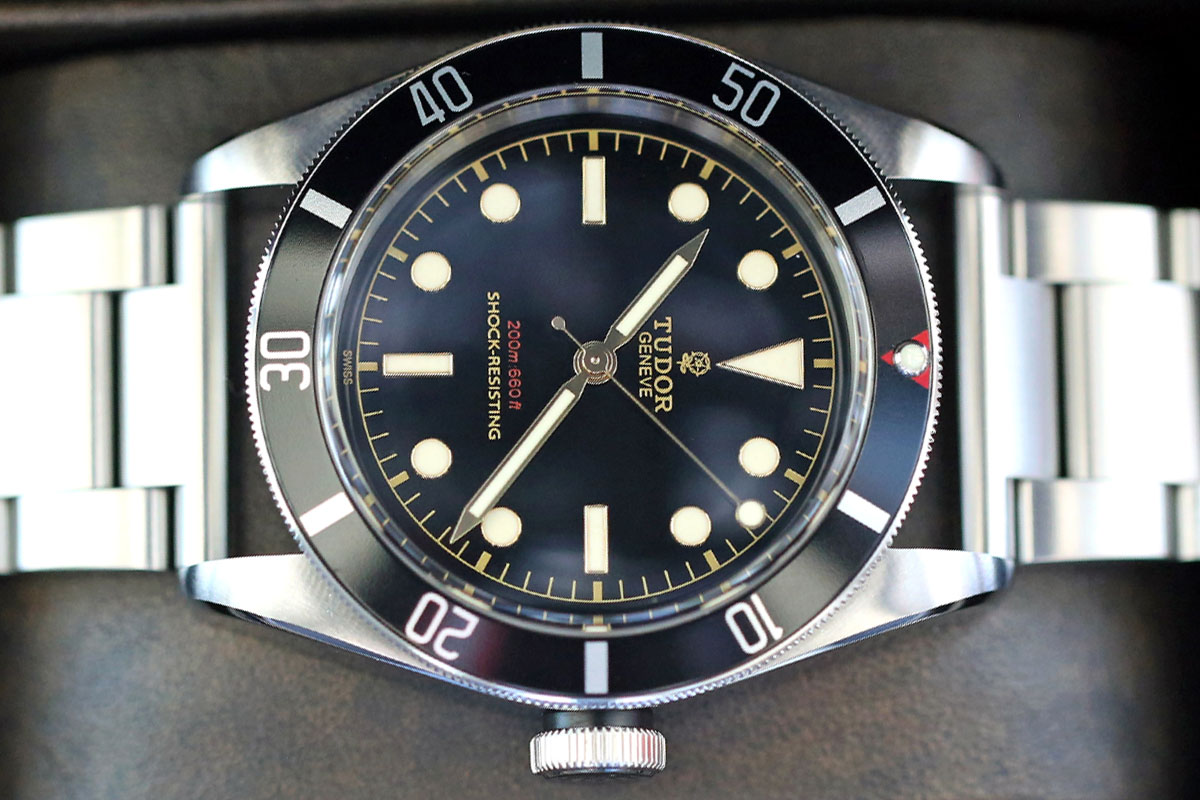



1 response
Brice,
Thanks for your very thorough essay on the Tudor Sub & beyond. Having loved the brand for decades it’s a joy seeing its mounting prominence & the magic of the true excellence of the new generation…My applause!
Regards, Mike Cotter